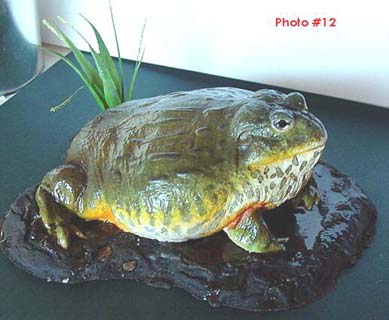The rear of the eye is then painted with any pattern or color that is desired, or, as illustrated by the example, it is painted with a dark brown pattern as seen in the living frog and then a reflective coat of pearl white and gold added to provide the iris color and to replicate a natural reflectivity.
The eye in this example was produced for a Pyxicephalus - the Giant African Bullfrog. It was painted accordingly.
Photo #9 shows the finished eye ready to set in a replica casting of the frog made here in the studio.
The frog was first positioned and frozen and then a two piece alginate mold made from the speciman. The alginate mold was cast in molding plaster and then chased, detailed and blocked.
An RTV mold was made of the initial or intermediate model and it was cast for the finished product(s). The RTV used was Rhodia's Vi-Sil 1062. The casting was made with Industrial Polymer's GT-85R, rigid co-polymer. The eyes were set by fitting in with Magic Sculpt and then the membranes were built using Epo-Grip's Industrial Adhesive to which pastel chalk dust was added to pigment it to match the living frog.
The base is made from Epo-Grip Epoxy Hide Paste to which powdered graphite, dry pigment and bits of materials were added. A Teflon cookie sheet was sprayed with Mann's 2251 mold release and the hide paste arranged on the surface.
The entire surface of the base was dusted with silt and sand and then the frog was placed naturally in the matrix. The center was scooped out in advance to provide a reservoir for resin water that was added last.
The base epoxy "Mud" was first sprayed with a clear matte lacquer to dull the peaks and then a quality gloss lacquer applied to the lower sections to replicate a muddy surface.
The "water" was made from Industrial Polymer's "Crystal Cast 9016". The plants were cast from Epo-Grip Ultra Clear and painted to suit.
The frog was coated with a combination of matte and gloss lacquers and eight thin coats (to represent the natural mucal covering) were applied in rapid succession after a primary coat of alcohol based fixatif to protect the WB acrylic paint used to pigment the frog. The entire frog was first coated with a white priming coat and then with an ultra pearlescent reflective coat so that the transparent colors could seem as natural as possible. All painting done with the Paasche VL, since no really fine detail was required.
I will offer additional eye making procedures for building larger eyes and multiple componend eyes for fish, birds and mammals later. Subsequent articles will include making molds from the eyes of living specimens. Hope this text spurs a renewed interest in one of the most common components in our field. I included the information about the frog and the base in an attempt to keep the "How'd ya do it?" emails to a minimum......good luck and good casting!!
